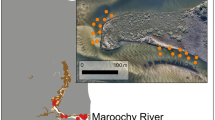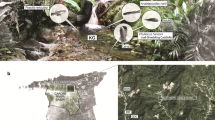Summary
In a series of laboratory experiments we examined the hypothesis that larvae of stream mayflies would respond to the presence of two different types of predators in such a way as to minimize their risk of being consumed by each. Positioning of larvae (whether they frequent the top, sides, or bottom of stones) of Baetis tricaudatus and Ephemerella subvaria was altered by the presence of predaceous stoneflies (Agnetina capitata) with a larger proportion of the population occurring on the upper surfaces, where the probability of encountering the predator was lowest. The presence of a benthivorous fish (Cottus bairdi) had no significant effects on positioning of the mayfly larvae. Lack of fish effects may reflect an inability of the mayflies to detect or respond to sculpins, or alternately may indicate that sculpins do not normally present a important predation risk for these mayflies. Failure of mayfly prey to account for fish predators when responding to the presence of stoneflies appcars to explain facilitation previously observed between stoneflies and sculpins.
Similar content being viewed by others
References
Andersson KG, Bronmark C, Herrmann J, Malmqvist B, Otto C, Sjorstrom P (1986) Presence of sculpins (Cottus gobio) reduces drift and activity of Gammarus pulex (Amphipoda). Hydrobiologia 133:209–215
Allan JD (1983) Predator-prey relationships in streams. In: Barnes JR, Minshall GW (eds) Stream ecology: application and testing of general ecological theory. Plenum Press, New York, NY, pp 191–229
Allan JD, Flecker AS, McClintock NL (1986) Diel epibenthic activity of mayfly nymphs, and its nonconcordance with behavioral drift. Limnol Oceanogr 31:1057–1065
Charnov EL, Orians GH, Hyatt K (1976) Ecological implications of resource depression. Am Nat 110:247–259
Dill LM (1987) Animal decision making and its ecological consequences: the future of aquatic ecology and behaviour. Can J Zool 65:803–811
Elliot JM (1968) The daily activity patterns of mayfly nymphs (Ephemeroptera). J Zool 155:201–221
Feltmate BW, Baker RL, Pointing PJ (1986) Distribution of the stonefly nymph Paragnetina media (Plecoptera: Perlidae): influence of prey, predators, current speed, and substrate composition. Can J Fish Aquat Sci 43:1582–1587
Flecker A, Allan JD (1984) The importance of predation, substrate and spatial refugia in determining lotic insect distributions. Oecologia (Berlin) 64:306–313
Grossman GD, Moyle PB, Whitaker JO (1982) Stochasticity in structural and functional characteristics of an Indiana stream fish assemblage: a test of community theory. Am Nat 120:423–454
Kohler SL (1985) Identification of stream drift mechanisms: an experimental and observational approach. Ecology 66:1749–1761
Peckarsky BL (1980) Predator-prey interactions between stoneflies and mayflies: behavioral observations. Ecology 61:932–943
Peckarsky BL (1983) Biotic interactions and abiotic limitations? A model of lotic community structure. In: Fontaine TD, Bartell SM (eds) Dynamics of lotic ecosystems. Ann Arbor Sci Publ, Ann Arbor, MI, pp 303–323
Peckarsky BL (1984) Predator-prey interactions among aquatic insects. In: Resh VH, Rosenberg DM (eds) The ecology of aquatic insects. Praeger, New York, pp 196–254
Reice SL, Edwards RL (1986) The effect of vertebrate predation on lotic macroinvertebrate communities in Quebec, Canada, Can J Zool 64:1930–1936
Shapiro SS, Wilk NB (1965) An analysis of variance test for normality (complete samples). Biometrika 52:591–611
Sih A (1987) Predators and prey lifestyles: an evolutionary and ecological overview. In: Kerfoot WC, Sih A (eds) Predation: direct and indirect impacts on aquatic communities. University of New England Press, Hanover, NH, pp 203–224
Soluk DA, Collins NC (1988a) A mechanism for interference between stream predators: responses of the stonefly Agnetina capitata to the presence of sculpins. Oecologia (in press)
Soluk DA, Collins NC (1988b) Synergistic interactions between fish and stoneflies: facilitation and interference between stream predators. Oikos 52:94–100
Ware DM (1973) Risk of epibenthic prey to predation by rainbow trout (Salmo gairdneri). J Fish Res Board Can 30:787–797
Williams DD (1986) Factors influencing the microdistribution of two sympatric species of Plecoptera: an experimental study. Can J Fish Aquat Sci 43:1005–1009
Williams DD (1987) A laboratory study of predator-prey interactions of stoneflies and mayflies. Freshwater Biol 17:471–490
Williams DD, Moore KA (1985) The role of semiochemicals in benthic community relationships of the lotic amphipod Gammarus pseudolimnaeus: a laboratory analysis. Oikos 44:280–286
Wilson EO (1971) The insect societies. Harvard University Press, Cambridge MA, pp 55–58
Zar JH (1984) Biostatistical analysis, 2nd edn. Prentice-Hall, Englewood Cliffs, NJ, pp 138–146
Author information
Authors and Affiliations
Rights and permissions
About this article
Cite this article
Soluk, D.A., Collins, N.C. Balancing risks? Responses and non-responses of mayfly larvae to fish and stonefly predators. Oecologia 77, 370–374 (1988). https://doi.org/10.1007/BF00378044
Received:
Issue Date:
DOI: https://doi.org/10.1007/BF00378044




